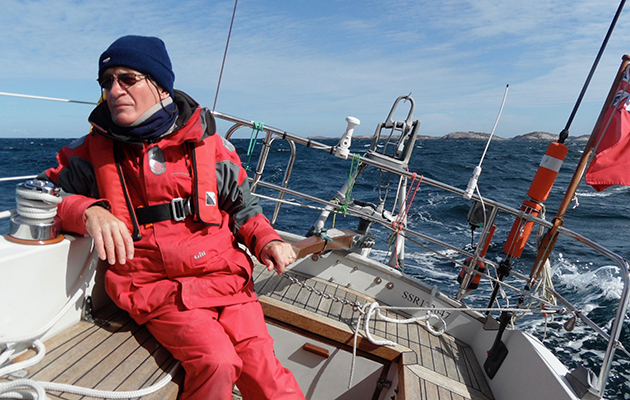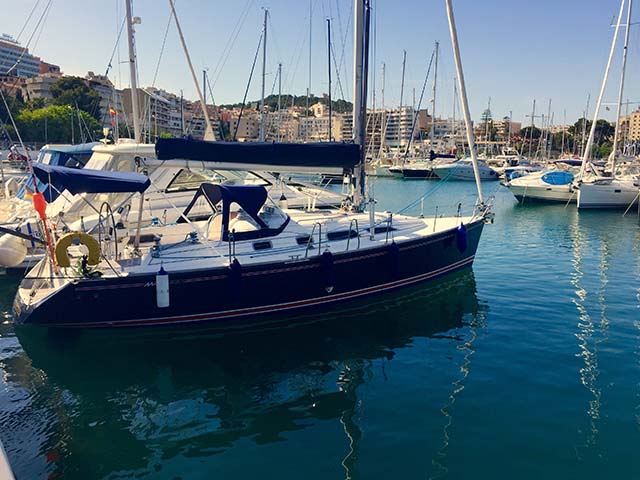With no inboard engine and a dead outboard, Josh Ghyselincks
discovers the joys of cruising across the Pacific under sail alone
‘The winds and sea were too strong to set up the storm jib steering so I hand-steered for close to 18 hours before the conditions settled enough. This was the start of a 1,300-mile run to Tonga and the forecast was not looking good. I thought I had finally been pushed too far and figured I just needed to get to a port and walk away from the boat for good.’
His well-battered palm frond hat, burnt brown by the sun, casts a shadow over his tanned face as Josh Ghyselincks recalls his trip from Bora Bora, one of the more difficult moments during his voyage from Mexico to New Zealand.
‘After another day, the wind died out and I flopped around, drifting for a day trying to rest. Finally a breeze filled in and I changed course for Aitutaki. Two days of glorious conditions made me reconsider my decision days before as I arrived in the Cook Islands, an unintended destination.’

Arriving in Tonga after 1,300 miles. Credit: Craig Koening
The fact that Maistral, Ghyselincks’ Arpege 29, didn’t have an inboard engine, only a 9.9hp Yamaha outboard, makes this tale of South Pacific cruising all the more fascinating, and earned him an accolade from the Ocean Cruising Club (OCC).
The OCC presented him with the Jester Award for 2017 in recognition of his solo 2,900-mile trip from Mexico to the Marquesas Islands in 24 days.
The award is given to skippers who complete noteworthy singlehanded voyages or series of voyages made in a vessel of 30ft or less overall, and pays tribute to the spirit and ideals of legendary sailors Blondie Hasler and Mike Richey.
Ghyselincks bought his 29ft yacht three years ago. Maistral had been on a swinging mooring for several years and it was her ‘simplicity and interior layout’ that attracted the 32 year old to the seasoned offshore yacht, which had no wind vane and very little navigation or communication equipment.

Ghyselincks believes that you don’t need ‘large sums of money and lifelong sailing experience’ to go cruising
‘I knew she had a history of offshore sailing so I felt she would be a good sailing boat without knowing why at the time. Lots of reading agreed with my gut feeling and so I became a boat owner the week before my 30th birthday,’ he recalls. ‘She was a proven passagemaker so I wasn’t concerned, I knew she that could do it again.’
Built in 1967 by Michel Dufour in La Rochelle, France, close to where Ghyselincks was born into an army family, Maistral was considered ‘unique at the time because of her modern design’ – a fin keel with a bulb and a skeg-hung rudder.
She belonged for many years to the OCC vice commodore Tony Gooch and his wife, Coryn, who sailed her 65,000 miles throughout the Atlantic and Pacific Oceans, most notably round Cape Horn via the Straits of Magellan.
‘I think what sets her apart nowadays in the cruising world are elements that may have been common in the past. At 29ft, she is often the smallest boat in an anchorage. She has no inboard engine. The electronics aboard amount to a cell phone, handheld VHF, portable SSB radio receiver, personal locator beacon, depth sounder, Bluetooth stereo and various LED lights,’ he explains.
Alternative living
For the first few months aboard Maistral, Ghyselincks had to use oil lamps as there was no way to charge the batteries.
He installed an 80W solar system and some LED lights, but thankfully found most of the yacht’s gear well maintained.
Concerned about large forces from waves using the outboard engine as leverage in the open ocean, he reinforced the transom where the outboard was attached.

The OCC Jester Award winner hopes the accolade will draw more attention to small boat sailing. CREDIT: Isabelle Arcand
Ghyselincks later found that while the outboard was easy to use (‘I could turn the boat on a dime), it showed its weakness offshore with the prop regularly flying out of the water.
Initial modifications made to Maistral, he then focused his attention on improving his sailing skills by taking to the waters around Victoria, British Columbia whenever he could.
Having banded together some crew, his first major trip was skippering Maistral down the west coast from Canada to Huatulco in Mexico and back up the Sea of Cortez (Gulf of California). By then, reflects Ghyselincks, ‘most of the kinks were out.’

Ghyselincks used the poled-out storm jib method of self-steering, along with bits of rope and shock cord. CREDIT: Isabella Arcand
A solo voyage from Mexico to the Marquesas Islands seemed to be a natural progression in his sailing education. The route is not an uncommon one for those who intend to follow the trade winds and keeps most of the sailing downwind.
‘I just wanted to see if I could do it. It was a personal challenge, just the sea and me,’ he says. ‘I was already in Mexico and knew that running further south along the coast meant very light wind conditions, so why not jump off from the continent?’
There was still one kink to shake out though before setting sail. ‘My main dilemma was regarding the steering. I had an ST2000 tiller pilot but it was only able to push, not pull, after half a year of use, so I decided to look for alternatives.’
Continues below…
Swapping half ropes for halyards
Facing shipwreck on a lee shore didn’t put him off sailing, but then having only one limb of four working…
Downsizing: an age-old conundrum
Bigger isn’t always better. As ageing joints make some jobs harder, Julian Mounter rediscovers the fun and freedom of a…
He found the answer in a book, Singlehanded Sailing: Thoughts, Tips, Techniques & Tactics by Andrew Evans (McGraw-Hill Education Europe, £18.99), who describes using a storm jib to steer a boat as an alternative if a wind vane or autopilot should fail.
With this new knowledge, Ghyselincks set about using the poled-out storm jib method of self-steering, along with bits of rope and shock cord.
He tried it out for the first time while sailing in the Bahía de Banderas, Mexico. ‘It took only a half hour to dial it in the first time and Maistral was cutting a straight line on a beam reach. I chuckled thinking of having hand-steered, with crew, from Canada when I had everything I needed aboard to make a self-steering system.’

Chilling in Tuamotu, French Polynesia. CREDIT: Isabella Arcand
I ask Ghyselincks whether he had to learn new skills or adapt in any other ways to compensate for the lack of an inboard engine.
He thinks for a while and then replies, ‘I would practice anchoring and manoeuvring to docks under sail anyway, just for a bit of fun.’
The practice under sail would later pay off when the outboard developed a large oil leak in the Marquesas Islands.
The engine could only be run for half an hour before a low oil alarm. After several unsuccessful attempts to repair it, Ghyselincks eventually gave up on the outboard, sailing from the Tuamotu Archipelago in French Polynesia to New Zealand without it.
‘Having no engine meant that timings and route became much more critical. There were a few hair-raising moments, but it’s been an easy transition and I never have to ask myself the question, “Do I motor or keep trying to sail?” When the wind really drops, I usually take all of the sails down and go below to make a coffee,’ he notes.
He believes that not having any engine certainly keeps cruising costs low. ‘From what I can tell, many cruisers spend a large amount of time and money maintaining their boats, and it’s often largely the motor,’ reflects Ghyselincks.
A touch of TLC
Once Ghyselincks had made port in Opua, a town located in the North Island, New Zealand, he decided to lavish some ‘well-deserved attention’ on to Maistral.
She has just gone back into the water after an extensive refit. The yacht now has a new mainsail, Pelagic tiller pilot and new standing rigging.
Any trace of the outboard has now been removed. Half the deck has been replaced due to a saturated core, and the rudder has been overhauled.
The 2017 recipient of the Ocean Cruising Club’s Jester Award doesn’t believe he can live up to the tales of Blondie Hasler and his modified Nordic Folkboat, Jester.

Ghyselincks had little formal sailing experience before embarking on his voyage. CREDIT: Isabella Arcand
But, he does think there may be ‘some value’ in his solo voyage for the current generation of adventure sailors.
‘I was both surprised and delighted at the acknowledgement by the Ocean Cruising Club. I know there are other cruising sailors out there with even smaller, simpler boats but it is becoming exceedingly rare from what I can gather. I think it’s great to bring some attention to the small-budget sailboat out there.’
Ghyselincks hopes his Pacific exploits will dispel any myths that one needs ‘large sums of money and lifelong sailing experience’ to go cruising.
‘The reality is that there are very affordable boats out there and there are places for anyone to get a start on the experience. I’ve been fortunate in that I’ve never been handed a sailing challenge that was impossible. As a friend of mine had told me, we are only given challenges in life which we can achieve.
‘Financially, living at anchor has been the most economical living I’ve done, although there is the price of discomfort. Not being able to stand straight up has its downsides,’ he quips, the smile lighting up his face.

The simplicity and interior layout of Maistral was a strong attraction for Ghyselincks. CREDIT: Isabelle Arcand
Ghyselincks is now planning to continue sailing ‘back up to the tropics and in the direction of the trades,’ although he is going to try taking on crew ‘to make the nights more restful.’
He says that some of his cruising experiences so far have been life changing.
‘The highest point of the trip so far has to be Palmerston Island in the Cook Islands, hands down. I was welcomed warmly and treated like family. It would be impossible to describe the generosity that I experienced but suffice to say, it changed my life.’
Ghyselincks hopes to have many more of these pivotal ‘life changing’ experiences as he continues his passage, totally engineless, across the Pacific Ocean.






